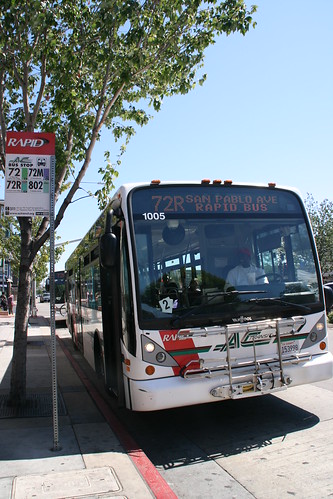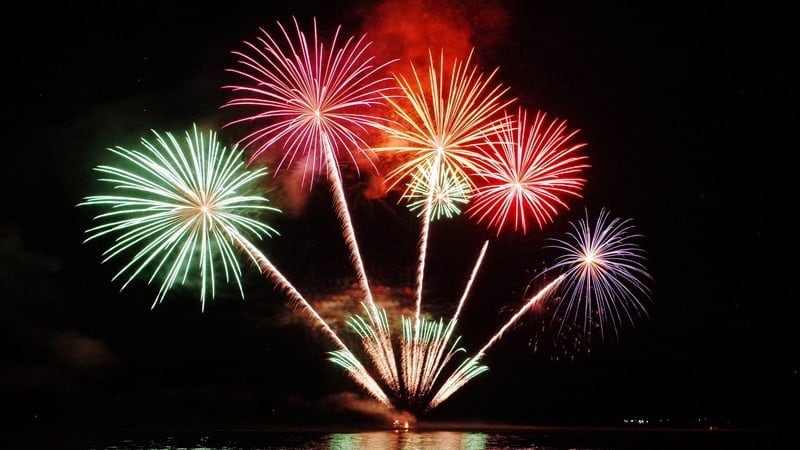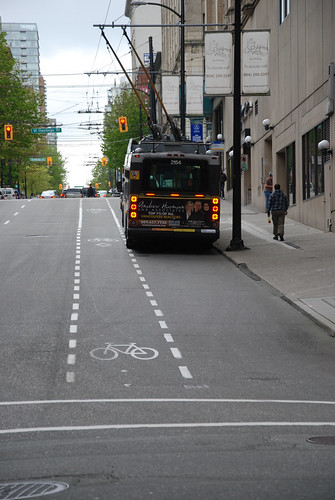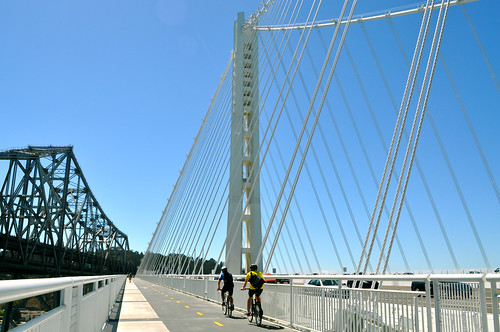
“The 72R made us look at our service in a whole new way and played an important part in the modernization of bus travel.”
– AC Transit Board Director Chris Peeples. Photo credit: AC Transit
Can you believe it? Back in June, AC Transit’s San Pablo Rapid Line – the 72R – turned 10 years old! Naturally, the milestone was celebrated (see photos here) and the line has many more years ahead of it.
So while we missed the 72R’s birthday it’s not too late to honor this work-horse of a bus line, it has been invaluable to many East Bay commuters. Just what makes the 72R so great, you ask? AC Transit the answer of course, with our emphasis added:
Line 72R made its debut on June 30, 2003, the result of an ambitious partnership among the seven cities through which it runs, Caltrans, and what was then the Alameda County Congestion Management Agency. The line is recognized not only by its bold red striping and logo, but also for its distinction as the first “enhanced bus” line in the Bay Area.
[…]
The 72R replaced what was then called the 72 Limited, or 72L, and cut travel time along its 14-mile San Pablo Avenue route by 17% compared to the 72Land 30% compared to the underlying local service. This was achieved by placing stops farther apart; eliminating set time points at individual stops and running buses every 12 minutes; and using state-of-the-art technology to coordinate traffic signals and hold green lights longer for buses. The line also featured, for the first time, 40-foot buses with three doors to facilitate exiting and bus shelters with electronic, real-time arrival displays.
Today, the San Pablo Rapid carries about 7,000 passengers each weekday to destinations between Jack London Square in Oakland and Contra Costa College in San Pablo. The service also complements the many residential developments and commercial enterprises that have sprung up along the corridor.
And as if that weren’t enough reason to love the 72R, there’s more!
In the San Pablo Rapid’s lifespan, the line has covered some serious ground, making 134 trips every weekday for a total of 4,735,556 miles. Taking this cumulative distance into consideration, the 72R could have travelled to the moon and back 10 times!
The line has worked a total of 2,530 weekdays, with only 80 holidays “off.” In that time, it has provided nearly 18 million individual passenger trips and has saved those riders a total of 57,718,099 minutes over its predecessor. Now that’s a timesaver!
Other fun facts?
- A year after its introduction, AC Transit ridership increased along the San Pablo corridor by 15% and 19% of new 72R passengers indicating that they previously drove.
- Many regular BART riders also switched to the bus or used the Rapid as a way to get to BART instead of taking their car.
- Ridership on the line has been steady.
It was because of the 72R’s success that AC Transit introduced the 1R and that an enhanced Bus Rapid Transit (BRT) line is scheduled to be available in 2017, connecting San Leandro and downtown Oakland with light rail quality but at a much cheaper price– a real win-win for the agency and riders.
Read more about the future of East Bay BRT over at AC Transit.









 While practically half of San Francisco lies within the 30-minute time zone, none of the trans-bay commuters now reach land within that time. All of the trans-bay districts are reached within an hour, the same as San Francisco. But for the former, from one-fourth to one-half of the time is consumed in the water trip. Shaded contour areas and time points within circles indicate how far commuters may ride within 10-minute intervals from the center of the business district-Third and Market Streets (allowing seven minutes to the Ferry terminal, and 10 minutes to the railroad terminal at Third and Townsend Streets). The inner shaded zones correspond to the running time by electric and cable lines. Double circles and the Peninsular zone particularly refer to steam lines. Running speed is indicated directly by the relative distance between these time points. For steam trains, the time shown is on limited local trains passing by only the less important stations. Some limited expresses make 26% better time, and way locals 15% slower time than here indicated. With the same character of rapid transit equipment, it appears that from 20 to 30 minutes more running time will always be necessary, by reason of the water trip, for trans-bay commuters to reach their homes than for San Franciscans, but that no such handicap exists as a limitation for Peninsular development.
While practically half of San Francisco lies within the 30-minute time zone, none of the trans-bay commuters now reach land within that time. All of the trans-bay districts are reached within an hour, the same as San Francisco. But for the former, from one-fourth to one-half of the time is consumed in the water trip. Shaded contour areas and time points within circles indicate how far commuters may ride within 10-minute intervals from the center of the business district-Third and Market Streets (allowing seven minutes to the Ferry terminal, and 10 minutes to the railroad terminal at Third and Townsend Streets). The inner shaded zones correspond to the running time by electric and cable lines. Double circles and the Peninsular zone particularly refer to steam lines. Running speed is indicated directly by the relative distance between these time points. For steam trains, the time shown is on limited local trains passing by only the less important stations. Some limited expresses make 26% better time, and way locals 15% slower time than here indicated. With the same character of rapid transit equipment, it appears that from 20 to 30 minutes more running time will always be necessary, by reason of the water trip, for trans-bay commuters to reach their homes than for San Franciscans, but that no such handicap exists as a limitation for Peninsular development.